Coburn J.W. Algebra and Trigonometry
Подождите немного. Документ загружается.

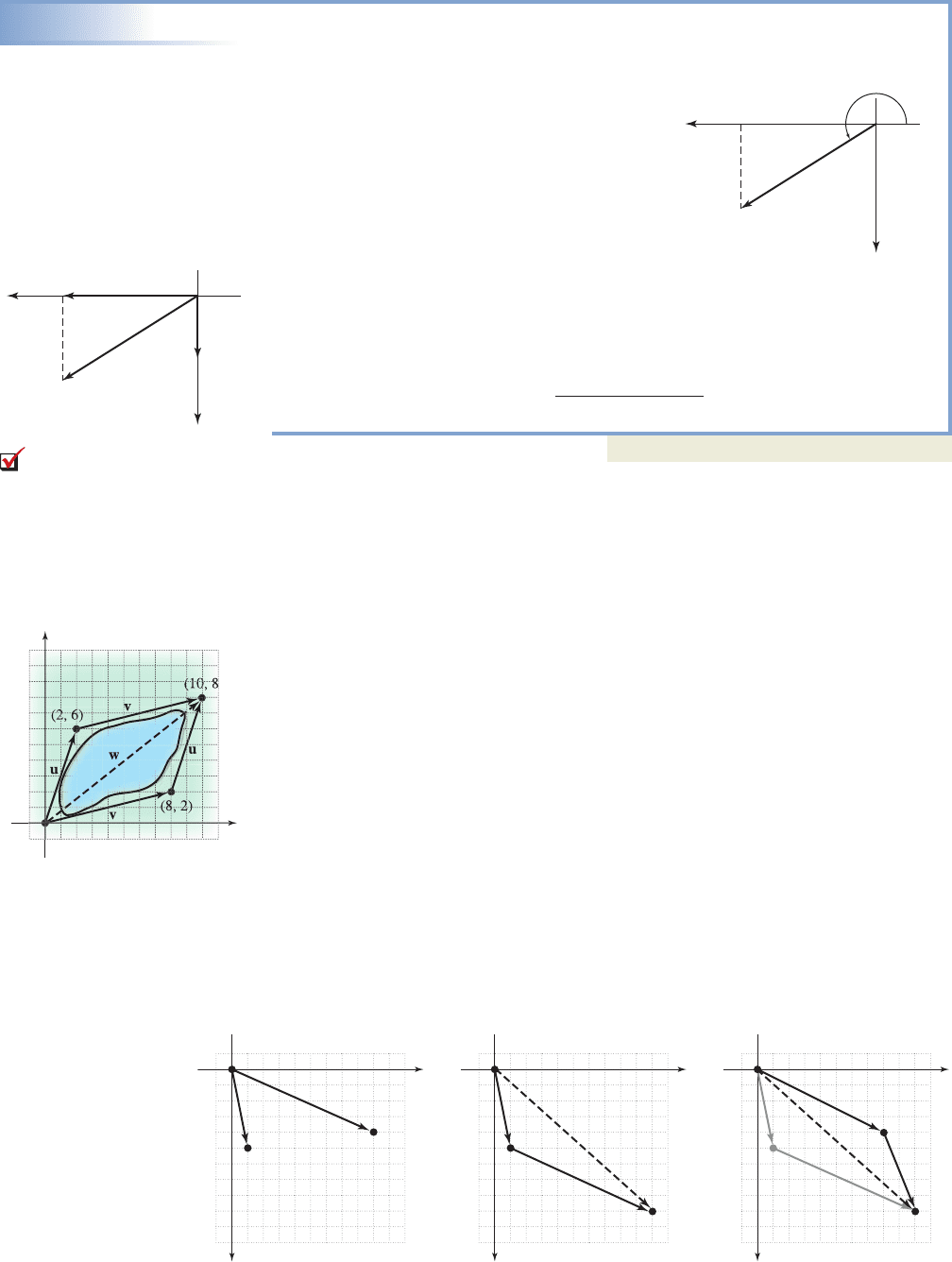
740 CHAPTER 7 Applications of Trigonometry 7-30
EXAMPLE 4
Finding the Horizontal and Vertical Components of a Vector
The vector is in QIII, has a magnitude
of and forms an angle of with the
negative x-axis (Figure 7.31). Find the
horizontal and vertical components of the
vector, rounded to tenths.
Solution
Begin by graphing the vector and setting up the
equations for its components. For
For the horizontal component: For the vertical component:
With v in QIII, its component form is approximately As a check, we
apply the Pythagorean theorem: ✓. See Figure 7.32.
Now try Exercises 25 through 30
C. Operations on Vectors and Vector Properties
The operations defined for vectors have a close knit graphical representation.
Consider a local park having a large pond with pathways around both sides, so that
a park visitor can enjoy the view from either side. Suppose is the position
vector representing a person who decides to turn to the right at the pond, while
represents a person who decides to first turn left. At (8, 2) the first person
changes direction and walks to (10, 8) on the other side of the pond, while the second
person arrives at (2, 6) and turns to head for (10, 8) as well. This is shown graphically
in Figure 7.33 and demonstrates that (1) a parallelogram is formed (opposite sides
equal and parallel), (2) the path taken is unimportant relative to the destination, and
(3) the coordinates of the destination represent the sum of corresponding coordinates
from the terminal points of u and v: In
other words, the result of adding u and v gives the new position vector
called the resultant or the resultant vector. Note the resultant vector is a diagonal
of the parallelogram formed. Geometrically or graphically, the addition of vectors can
be viewed as a “tail-to-tip” combination of one with another, by shifting one vector
(without changing its direction) so that its tail (initial point) is at the tip (terminal
point) of the other vector. This is illustrated in Figures 7.34 through 7.36.
u v w,
12, 62 18, 22 12 8, 6 22 110, 82.
u H2, 6I
v H8, 2I
21192
2
18.92
2
21
H19, 8.9I.
8.9 19
21 sin 205° 21 cos 205°
b
v
sin a
v
cos
205°.
r
25°,
25°
v
21,
v Ha, bI
Figure 7.33
v
x
y
2
(2
)
8
0
(
(10 8
)
Figure 7.34
x
y
v
u
Figure 7.35
x
y
v
u
u v
H10, 9I
Tail of v to
the tip of u
Figure 7.36
x
y
v
v
u
u
u v
H10, 9I
Tail of u to
the tip of v
Figure 7.32
yy
xx
|v| 21|v| 21
Ha, bI
25
19
8.9
Figure 7.31
yy
xx
|v| 21|v| 21
Ha, bI
25
205
B. You’ve just learned how
to represent a vector quantity
graphically
Given vectors u and v
Shift vector v
Shift vector u
College Algebra & Trignometry—
cob19529_ch07_736-752.qxd 11/19/08 2:26 AM Page 740 epg HD 049:Desktop Folder:Satya 18/11/08:
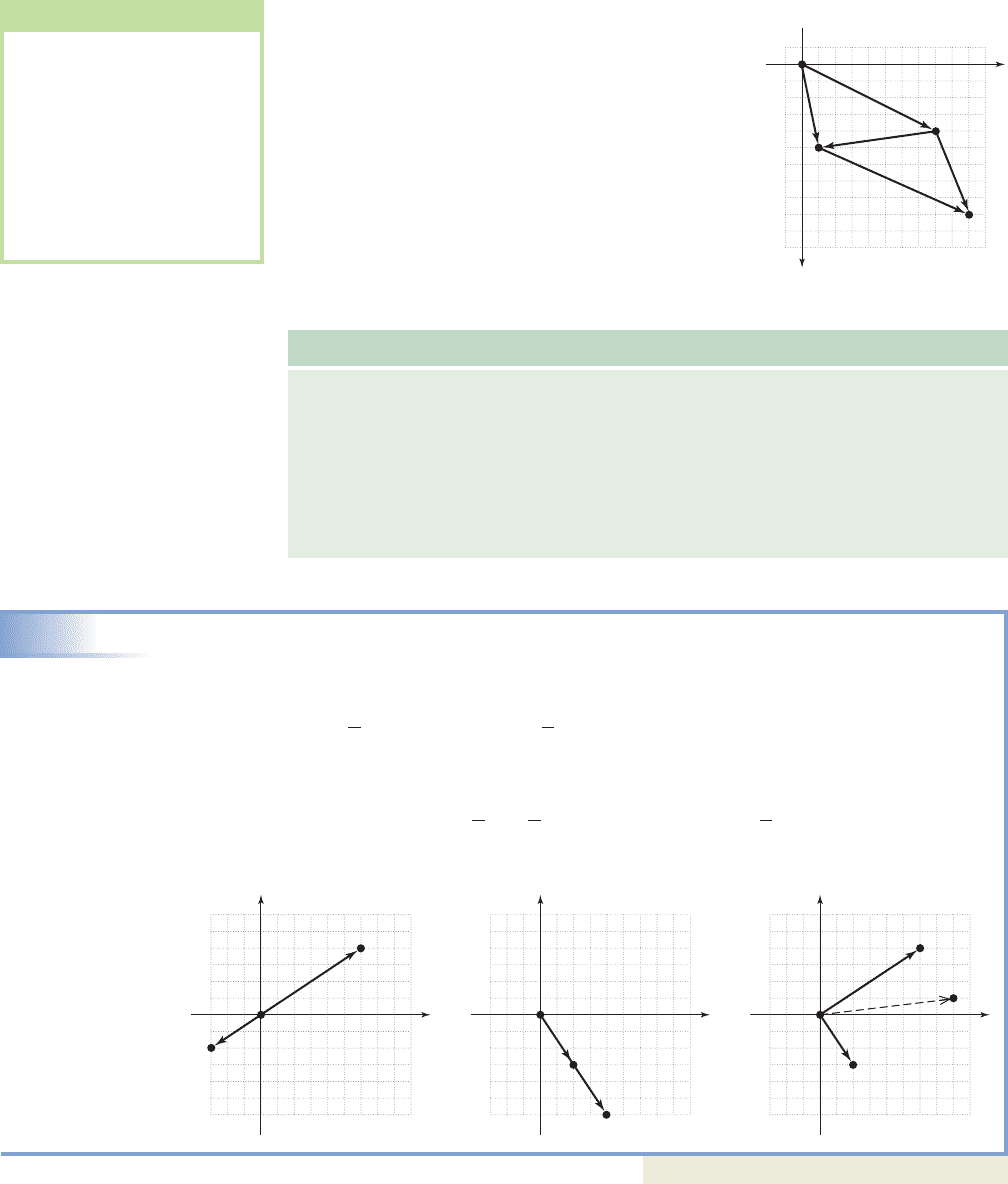
x
y
H6, 4I
H3, 2I
u
2u
x
y
H2, 3I
v H4, 6I
qv
x
y
H2, 3I
2
u
H6, 4I
H8, 1I
qv
7-31 Section 7.3 Vectors and Vector Diagrams 741
The subtraction of vectors can be understood as
either as or Since the location of a
vector is unimportant relative to the information it
carries, vector subtraction can be interpreted as the tip-
to-tip diagonal of the parallelogram from vector addi-
tion. In Figures 7.34 to 7.36, assume
and Then
giving the position vector .
By repositioning this vector with its tail at the tip of v,
we note the new vector points directly at u,forming the
diagonal (see Figure 7.37). Scalar multiplication of
vectors also has a graphical representation that corre-
sponds to the geometric description given earlier.
Operations on Vectors
Given vectors and a scalar k,
1.
2.
3. for
If the new vector points in the same direction as u.
If the new vector points in the opposite direction as u.
EXAMPLE 5
Representing Operations on Vectors Graphically
Given and compute each of the following and represent the result
graphically:
a. b. c.
Note the relationship between part (c) and parts (a) and (b).
Solution
a. b. c.
Now try Exercises 31 through 48
The properties that guide operations on vectors closely resemble the familiar
properties of real numbers. Note we define the zero vector as one having no
magnitude or direction.
0 H0, 0I
H8, 1I H2, 3I H6, 4I
2u
1
2
v H6, 4I H2, 3I
1
2
v
1
2
H4, 6I2u 2H3, 2I
2u
1
2
v
1
2
v2u
v H4, 6Iu H3, 2I
k 6 0,
k 7 0,
k ku Hka, kbI
u v Ha c, b dI
u v Ha c, b dI
u Ha, bI, v Hc, dI,
H8, 1IH1 9, 5 4I
H9, 4I u v H1, 5Iv H9, 4I.
u H1, 5I
u 1v2.u v
Figure 7.37
x
y
v
v
u
u
u v
(repositioned)
WORTHY OF NOTE
The geometry of vector
subtraction is a key part of
resolving a vector into
orthogonal components that
are nonquadrantal. Applica-
tions of this concept are
wide ranging, and include
thrust and drag forces,
tension and stress limits in a
cable, and others.
College Algebra & Trignometry—
cob19529_ch07_736-752.qxd 11/19/08 2:27 AM Page 741 epg HD 049:Desktop Folder:Satya 18/11/08:
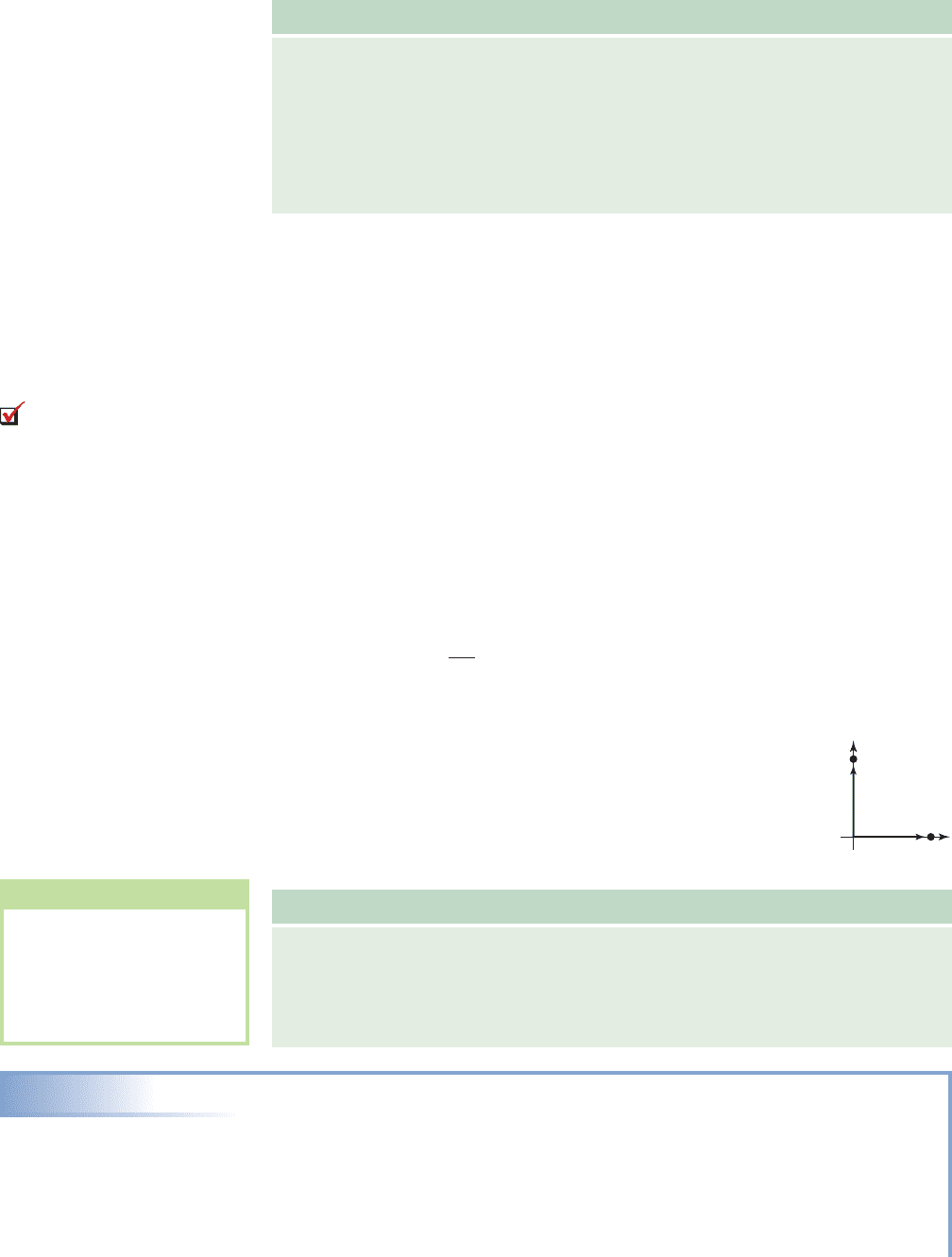
742 CHAPTER 7 Applications of Trigonometry 7-32
Properties of Vectors
For vector quantities u, v, and w and real numbers c and k,
1. 2.
3. 4.
5. 6.
7. 8.
9. 10.
Proof of Property 3
For and we have
sum of u and v
vector addition
commutative property
vector addition
result
Proofs of the other properties are similarly derived (see Exercises 89 through 97).
D. Algebraic Vectors, Unit Vectors, and i, j Form
While the bold, small case v and the notation for vectors has served us well,
we now introduce an alternative form that is somewhat better suited to the algebra
of vectors, and is used extensively in some of the physical sciences. Consider the
vector a vector 1 unit in length extending along the x-axis. It is called the hor-
izontal unit vector and given the special designation i (not to be confused with the
imaginary unit ). Likewise, the vector is called the vertical unit vec-
tor and given the designation j (see Figure 7.38). Using scalar multiplication, the unit
vector along the negative x-axis is and along the negative y-axis is
. Similarly, the vector 4i represents a position vector 4 units long
along the x-axis, and represents a position vector 5 units long
along the negative y-axis. Using these conventions, any nonquadran-
tal vector can be written as a linear combination of i and j, with
a and b expressed as multiples of i and j, respectively: These
ideas can easily be generalized and applied to any vector.
Algebraic Vectors and i, j Form
For the unit vectors and any arbitrary vector
can be written as a linear combination of i and j:
Graphically, v is being expressed as the resultant of a vector sum.
EXAMPLE 6
Finding the Horizontal and Vertical Components of Algebraic Vectors
Vector u is in QII, has a magnitude of 15, and makes an angle of with the
negative x-axis.
a. Graph the vector.
b. Find the horizontal and vertical components (round to one decimal place) then
write u in component form.
c. Write u in terms of i and j.
20°
v ai bj
v Ha, bIj H0, 1I,i H1, 0I
ai bj.
Ha, bI
5j
j
i
H0, 1Ii 11
H1, 0I,
Ha, bI
v u
Hc, dI Ha, bI
Hc a, d bI
Ha c, b dI
u v Ha, bI Hc, dI
v Hc, dI,u Ha, bI
1c k2u cu kuk1u v2 ku kv
u 1u2 0u 0 u
1ck2u c1ku2 k1cu21u v2 w u 1v w2
u v u 1v2u v v u
0u 0 k01u u
C. You’ve just learned how
to perform defined operations
on vectors
Figure 7.38
y
x
j
i
(0, 1)
(1, 0)
WORTHY OF NOTE
Earlier we stated, “Two
vectors were equal if they
have the same magnitude
and direction.” Note that this
means two vectors are equal
if their components are equal.
College Algebra & Trignometry—
cob19529_ch07_736-752.qxd 11/19/08 2:27 AM Page 742 epg HD 049:Desktop Folder:Satya 18/11/08:
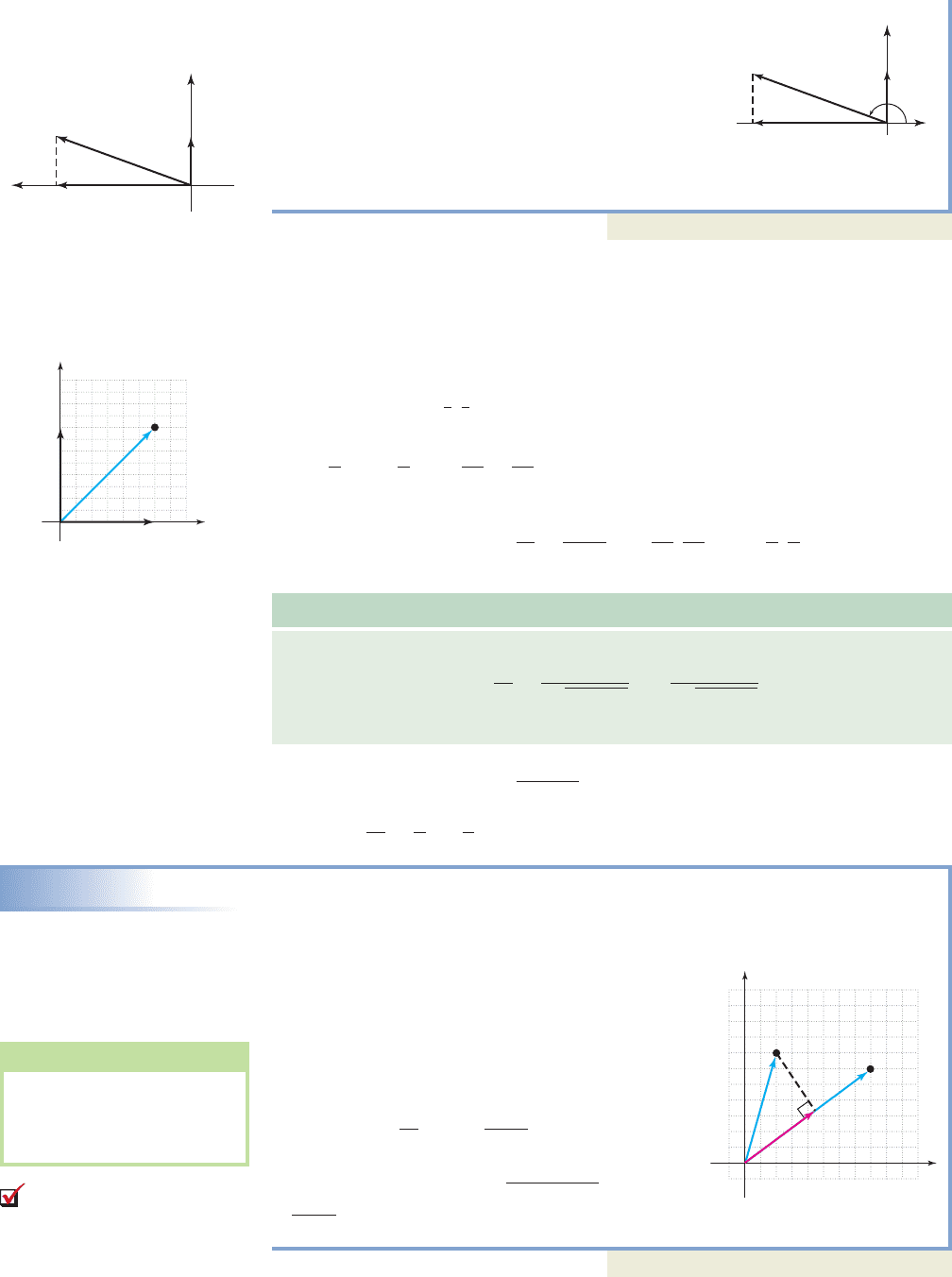
7-33 Section 7.3 Vectors and Vector Diagrams 743
Solution
a. The vector is graphed in Figure 7.39.
b.
Horizontal Component Vertical Component
With the vector in QII, in component form.
c. In terms of i and j we have See Figure 7.40
Now try Exercises 49 through 62
Some applications require that we find a nonhorizontal, nonvertical vector one
unit in length, having the same direction as a given vector v. To understand how
this is done, consider vector Using the Pythagorean theorem we find
and can form a 6-8-10 triangle using the horizontal and vertical components
(Figure 7.41). Knowing that similar triangles have sides that are proportional, we can
find a unit vector in the same direction as v by dividing all three sides by 10, giving
a triangle with sides and 1. The new vector “u” (along the hypotenuse) indeed
points in the same direction since we have merely shortened v, and is a unit vector
since In retrospect, we have divided the components
of vector v by its magnitude (or multiplied components by the reciprocal of ) to
obtain the desired unit vector: In general we
have the following:
Unit Vectors
For any nonzero vector the vector
is a unit vector in the same direction as v.
You are asked to verify this relationship in Exercise 100. In summary, for vector
we find so the unit vector pointing in the same
direction is . See Exercises 63 through 74.
EXAMPLE 7
Using Unit Vectors to Find Coincident Vectors
Vectors u and v form the angle illustrated in the figure. Find the vector w (in
red), which points in the same direction as v (is coincident with v) and forms the
base of the right triangle shown.
Solution
Using the Pythagorean theorem we find
and Using the cosine of the magnitude
of w is then or about 5.8. To ensure
that w will point in the same direction as v, we
simply multiply the 5.8 magnitude by the unit
vector for v:
and we find that As a check we use
the Pythagorean theorem:
Now try Exercises 75 through 78
133.41 5.8.
24.6
2
3.5
2
w H4.6, 3.5I.
w
v
v
15.82
H8, 6I
10
15.82H0.8, 0.6I,
w
7.3 cos 37°
37°
v
10.
u
7.3
37°
v
v
3
5
i
4
5
j
v
26
2
8
2
10,v 6i 8j,
b
2a
2
b
2
ju
v
v
a
2a
2
b
2
i
v Ha, bI ai bj,
v
v
H6, 8I
10
h
6
10
,
8
10
i h
3
5
,
4
5
i.
v
v
a
3
5
b
2
a
4
5
b
2
S
9
25
16
25
1.
3
5
,
4
5
,
v
10,
v H6, 8I.
u 14.1i 5.1j.
u H14.1, 5.1I
5.1 14.1
15 sin 160 ° 15 cos 160°
b
v
sin a
v
cos
Figure 7.41
x
y
H6, 8I
8
10
6
v
x
y
H2, 7I
H8, 6I
37
v
w
u
D. You’ve just learned how
to represent a vector quantity
algebraically and find unit
vectors
WORTHY OF NOTE
In this context w is called the
projection of u on v, an idea
applied more extensively in
Section 7.4
Figure 7.40
20
yy
xx
|u| 15|u| 15
Ha, bI
14.1
5.1
Figure 7.39
y
x
|u| 15
20
160
Ha, bI
College Algebra & Trignometry—
cob19529_ch07_736-752.qxd 11/19/08 2:27 AM Page 743 epg HD 049:Desktop Folder:Satya 18/11/08:
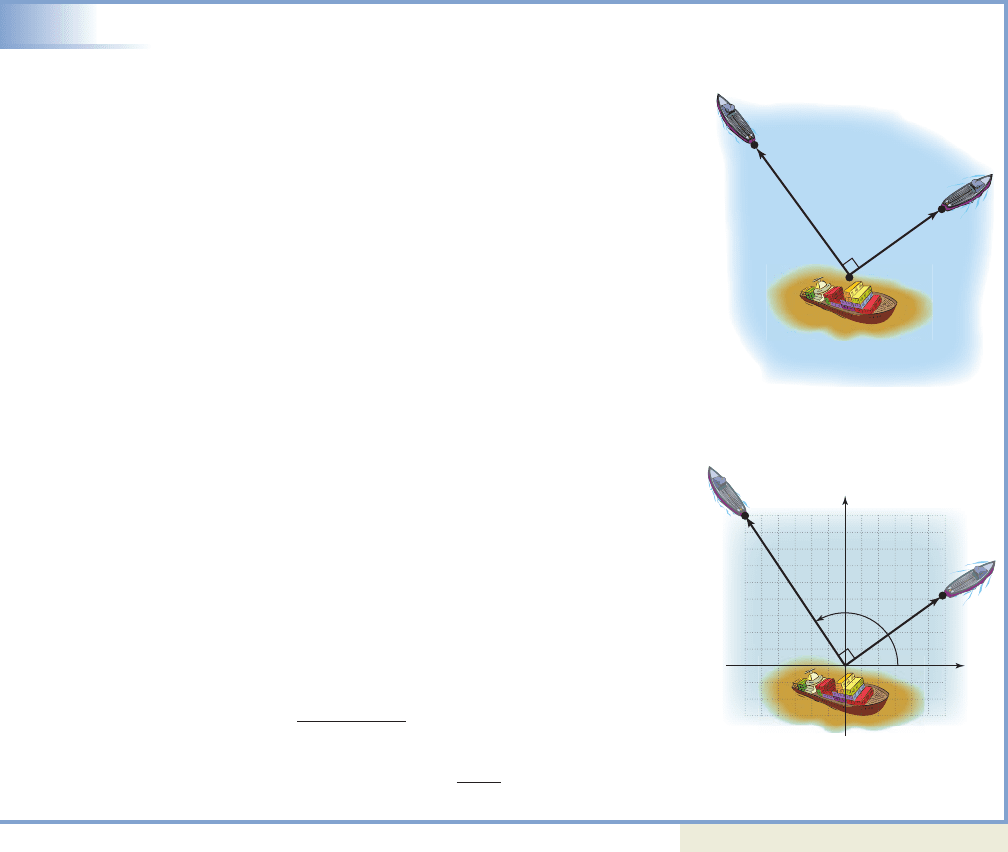
744 CHAPTER 7 Applications of Trigonometry 7-34
E. Vector Diagrams and Vector Applications
Applications of vectors are virtually unlimited, with many of these in the applied
sciences. Here we’ll look at two applications that are an extension of our work in this
section. In Section 7.4 we’ll see how vectors can be applied in a number of other
creative and useful ways.
In Example 1, two tugboats were pulling on a barge to dislodge it from a sand bar,
with the pulling force of each represented by a vector. Using our knowledge of vector
components, vector addition, and resultant forces (a force exerted along the result-
ant), we can now determine the direction and magnitude of the resultant force if we
know the angle formed by one of the vector forces and the barge.
EXAMPLE 8
Solving an Application of Vectors—Force Vectors Acting on a Barge
Two tugboats are attempting to free a barge that is stuck on a
sand bar, and are exerting the forces shown in Figure 7.42.
Find the magnitude and direction of the resultant force.
Solution
Begin by orienting the diagram on a coordinate grid (see
Figure 7.43). Since the angle between the vectors is we
know the acute angle formed by the first tugboat and the
x-axis is With this information, we can write each vector
in “i, j” form and add the vectors to find the resultant.
For vector v
1
(in QII):
Horizontal Component Vertical Component
For vector v
2
(in QI):
Horizontal Component Vertical Component
This gives a resultant of
with magnitude
N. To find the direction
of the force, we have or about
Now try Exercises 81 and 82
It’s worth noting that a single tugboat pulling at with a force of 2499 N would
have the same effect as the two tugs in the original diagram. In other words, the result-
ant vector truly represents the “result” of the two forces.
Knowing that the location of a vector is unimportant enables us to model and solve
a great number of seemingly unrelated applications. Although the final example con-
cerns aviation, headings, and crosswinds, the solution process has a striking similar-
ity to the “tugboat” example just discussed. In navigation, headings involve a single
82i 2498j
88°
88°.
r
tan
1
a
2498
82
b,
v
1
v
2
282
2
2498
2
2499
11229i 860j2 82i 2498j,
v
1
v
2
11147i 1638j2
v
2
1229i 860j.
860 1229
1500 sin 35° 1500 cos 35°
b
v
2
sin a
v
2
cos
v
1
1147i 1638j.
1638 1147
2000 sin 125° 2000 cos 125°
b
v
1
sin a
v
1
cos
55°.
90°,
Figure 7.42
2000
N
1500
N
35
°
Figure 7.43
x
y
2000
N
1500
N
55
125
35
v
1
v
2
College Algebra & Trignometry—
cob19529_ch07_736-752.qxd 11/25/08 21:05 Page 744
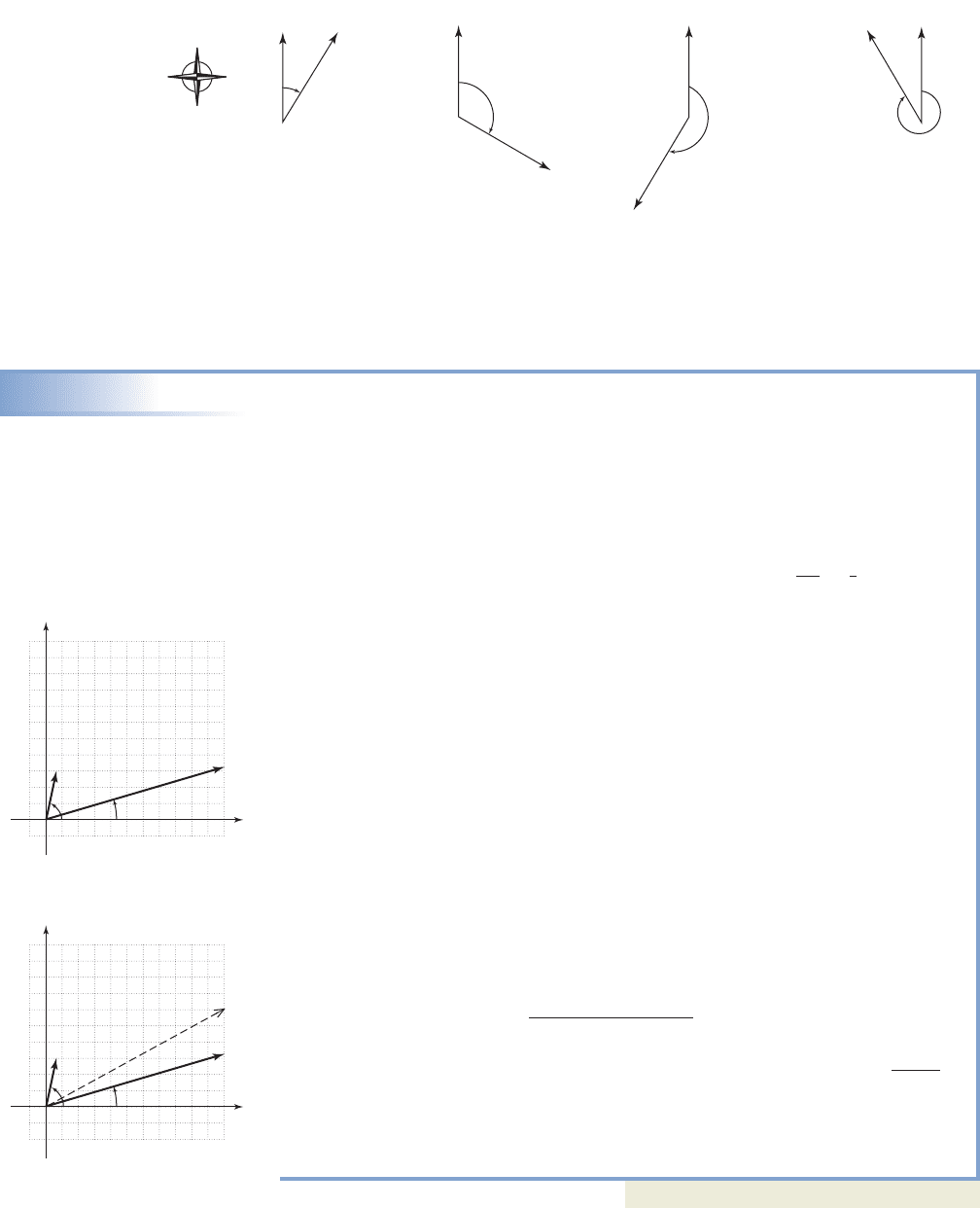
7-35 Section 7.3 Vectors and Vector Diagrams 745
In order to keep an airplane on course, the captain must consider the direction and
speed of any wind currents, since the plane’s true course (relative to the ground) will
be affected. Both the plane and the wind can be represented by vectors, with the plane’s
true course being the resultant vector.
EXAMPLE 9
Solving an Application of Vectors—Airplane Navigation
An airplane is flying at 240 mph, heading , when it suddenly encounters a
strong, 60 mph wind blowing from the southwest, heading What is the actual
course and speed of the plane (relative to the ground) as it flies through this wind?
Solution
Begin by drawing a vector p to represent the speed and direction of the airplane
(Figure 7.48). Since the heading is the angle between the vector and the x-axis
must be For convenience (and because location is unimportant) we draw it as a
position vector. Note the vector w representing the wind will be as long, and
can also be drawn as a position vector—with an acute angle. To find the
resultant, we first find the components of each vector, then add. For vector w (in QI):
Horizontal Component Vertical Component
For vector p (in QI):
Horizontal Component Vertical Component
The resultant is
with magnitude mph (see Figure 7.49).
To find the heading of the plane relative to the ground we use
which shows The plane is flying on a course heading of
at a speed of about 270.8 mph relative to the ground. Note
the airplane has actually “increased speed” due to the wind.
Now try Exercises 83 through 86
90° 26.6° 63.4°
r
26.6°.
r
tan
1
a
121.2
242.2
b,
w p
21242.22
2
1121.22
2
270.8
1231.8i 62.1j2 242.2i 121.2j,w p 110.4i 59.1j2
p 231.8i 62.1j.
62.1 231.8
240 sin 15° 240 cos 15°
b
p
sin a
p
cos
w 10.4i 59.1j.
59.1 10.4
60 sin 80° 60 cos 80°
b
w
sin a
w
cos
80°
60
240
1
4
15°.
75°,
10°.
75°
Figure 7.45
Headin
g
115
115
Figure 7.47
Heading 330
330
Figure 7.46
Heading 210
210
Figure 7.48
x
y
80
15
p
w
Figure 7.49
x
y
80
15
p
w
w p
Figure 7.44
30
Heading 30
North
South
West East
angle, which is understood to be the amount of rotation from due north in the clock-
wise direction. Several headings are illustrated in Figures 7.44 through 7.47.
College Algebra & Trignometry—
cob19529_ch07_736-752.qxd 11/19/08 2:27 AM Page 745 epg HD 049:Desktop Folder:Satya 18/11/08:
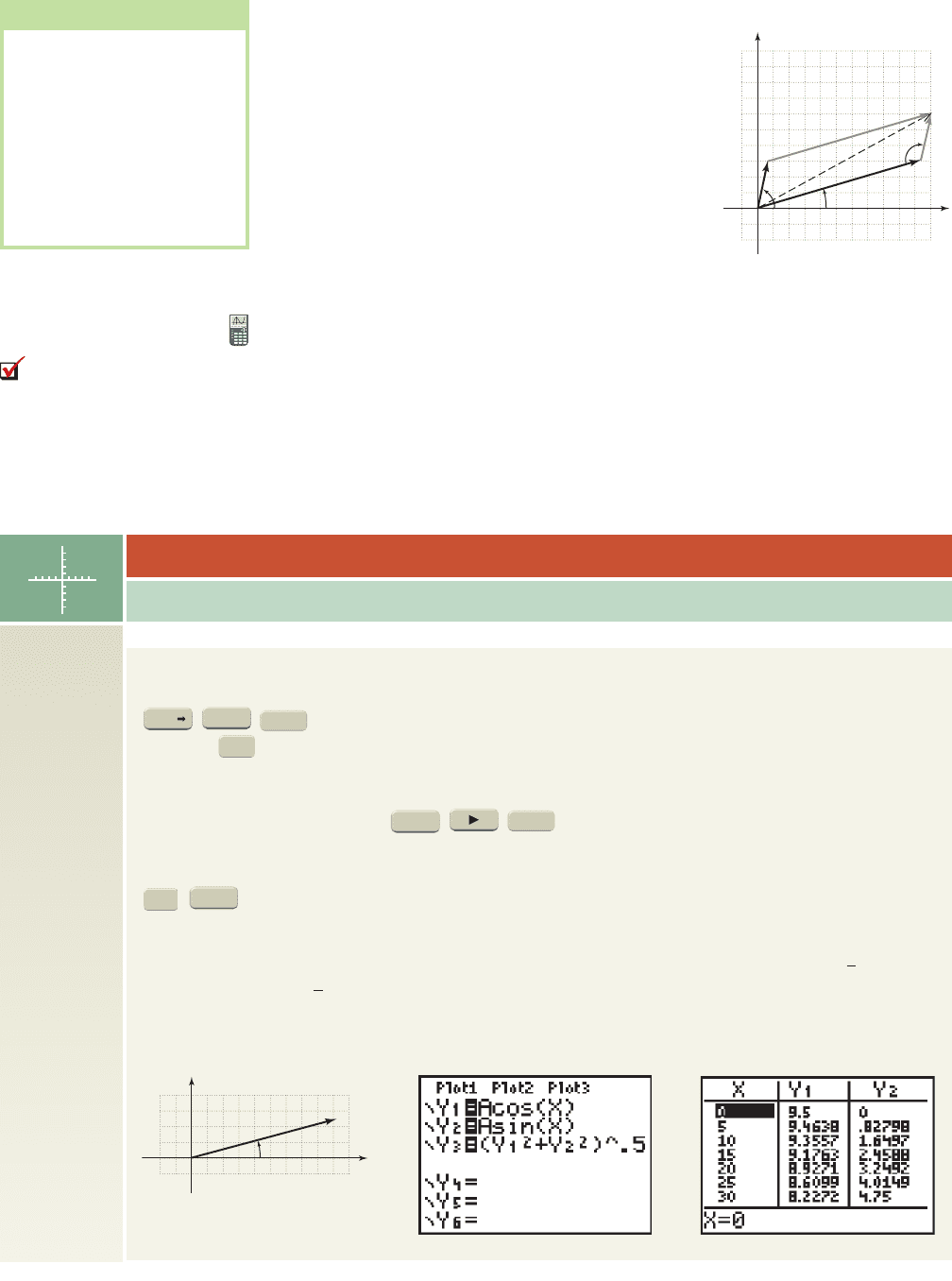
746 CHAPTER 7 Applications of Trigonometry 7-36
Applications like those in Examples 8 and 9 can
also be solved using what is called the parallelogram
method, which takes its name from the tail-
to-tip vector addition noted earlier (See Figure 7.50).
The resultant will be a diagonal of the parallelogram,
whose magnitude can be found using the law of
cosines. For Example 9, we note the parallelogram has
two acute angles of and since the
adjacent angles must sum to
,
the obtuse angles
must be . Using the law of cosines,
law of cosines
substitute 240 for p, 60 for w
compute result
take square roots
Note this answer is slightly more accurate, since there was no rounding until the
final stage.
w p
270.9
73371.40594
240
2
60
2
2124021602 cos 115°
w p
2
p
2
w
2
2pw cos 115°
115°
180°
180 152° 65°,
Figure 7.50
x
y
80
15
115
p
w
w p
E. You’ve just learned how
to use vector diagrams to
solve applications
Vector Components Given the Magnitude and the Angle
TECHNOLOGY HIGHLIGHT
The TABLE feature of a graphing calculator can help us find the horizontal and vertical components of
any vector with ease. Consider the vector v shown in Figure 7.51, which has a magnitude of 9.5 with
Knowing this magnitude is used in both computations, first store 9.5 in storage location A: 9.5
. Next, enter the expressions for the horizontal and vertical components as Y
1
and
Y
2
on the screen (see Figure 7.52). Note that storing the magnitude 9.5 in memory will prevent our
having to alter Y
1
and Y
2
as we apply these ideas to other values of . As an additional check, note that
Y
3
recomputes the magnitude of the vector using the components generated in Y
1
and Y
2
. To access
the function variables we press: and select the desired function. Although our
primary interest is the components for we use the TBLSET screen to begin at TblStart
and have it count AUTOmatically, so we can make additional observations. Pressing
(TABLE) brings up the screen shown in Figure 7.53. As expected, at the horizontal
component is the same as the magnitude and the vertical component is zero. At we have the
components of the vector pictured in Figure 7.51, approximately If the angle were
increased to a 30-60-90 triangle could be formed and one component should be times the
other. Sure enough, 13
14.752 8.2272.
13
30°,
H9.18, 2.46I.
15°
0°
GRAPH
2nd
0°, ¢Tbl 5,
15°,
ENTER
VARS
Y =
MATH
ALPHA
STO
15°.
x
y
15
v
Figure 7.51
Figure 7.52
Figure 7.53
WORTHY OF NOTE
Be aware that using the
rounded values of
intermediate calculations
may cause slight variations in
the final result. In Example 9,
if we calculate
then find the result is
actually closer to 270.9 mph.
w p
,
160 sin 80° 240 sin 15°2j,
160 cos 80° 240 cos 15°2i
w p
College Algebra & Trignometry—
cob19529_ch07_736-752.qxd 11/19/08 2:27 AM Page 746 epg HD 049:Desktop Folder:Satya 18/11/08:

7-37 Section 7.3 Vectors and Vector Diagrams 747
Exercise 1: If what would you know about the lengths of the horizontal and vertical compo-
nents? Scroll down to to verify.
Exercise 2: If what would you know about the lengths of the horizontal and vertical compo-
nents? Scroll down to to verify.
Exercise 3: We used column Y
3
as a double check on the magnitude of v for any given What would
this value be for and ? Press the right arrow to verify. What do you notice?
60° 45°
.
60°
60°,
45°
45°,
CONCEPTS AND VOCABULARY
Fill in each blank with the appropriate word or phrase.
Carefully reread the section if needed.
1. Measurements that can be described using a single
number are called quantities.
2. quantities require more than a single
number to describe their attributes. Examples are
force, velocity, and displacement.
3. To represent a vector quantity geometrically we
use a segment.
4. Two vectors are equal if they have the same
and .
5. Discuss/Explain the geometric interpretation of
vector addition. Give several examples and
illustrations.
6. Describe the process of finding a resultant vector
given the magnitude and direction of two arbitrary
vectors u and v. Follow-up with an example.
DEVELOPING YOUR SKILLS
Draw the comparative geometric vectors indicated.
7. Three oceanic research vessels are traveling on a
parallel course in the same direction, mapping the
ocean floor. One ship is traveling at 12 knots
(nautical miles per hour), one at 9 knots, and the
third at 6 knots.
8. As part of family reunion activities, the Williams
Clan is at a bowling alley and using three lanes.
Being amateurs they all roll the ball straight on,
aiming for the 1 pin. Grand Dad in Lane 1 rolls his
ball at 50 ft/sec. Papa in Lane 2 lets it rip at
60 ft/sec, while Junior in Lane 3 can muster only
30 ft/sec.
9. Vector v
1
is a geometric vector representing a boat
traveling at 20 knots. Vectors v
2
, v
3
, and v
4
are
geometric vectors representing boats traveling at
10 knots, 15 knots, and 25 knots, respectively.
Draw these vectors given that v
2
and v
3
are
traveling the same direction and parallel to v
1
,
while v
4
is traveling in the opposite direction and
parallel to v
1
.
10. Vector F
1
is a geometric vector representing a force
of 50 N. Vectors F
2
, F
3
, and F
4
are geometric
vectors representing forces of 25 N, 35 N, and
65 N, respectively. Draw these vectors given that
F
2
and F
3
are applied in the same direction and
parallel to F
1
, while F
4
is applied in the opposite
direction and parallel to F
1
.
Represent each situation described using geometric
vectors.
11. Two tractors are pulling at a stump in an effort to
clear land for more crops. The Massey-Ferguson is
pulling with a force of 250 N, while the John Deere
is pulling with a force of 210 N. The chains attached
to the stump and each tractor form a angle.
12. In an effort to get their mule up and plowing again,
Jackson and Rupert are pulling on ropes attached to
the mule’s harness. Jackson pulls with 200 lb of
force, while Rupert, who is really upset, pulls with
220 lb of force. The angle between their ropes is 16°.
25°
7.3 EXERCISES
College Algebra & Trignometry—
cob19529_ch07_736-752.qxd 12/30/08 18:19 Page 747
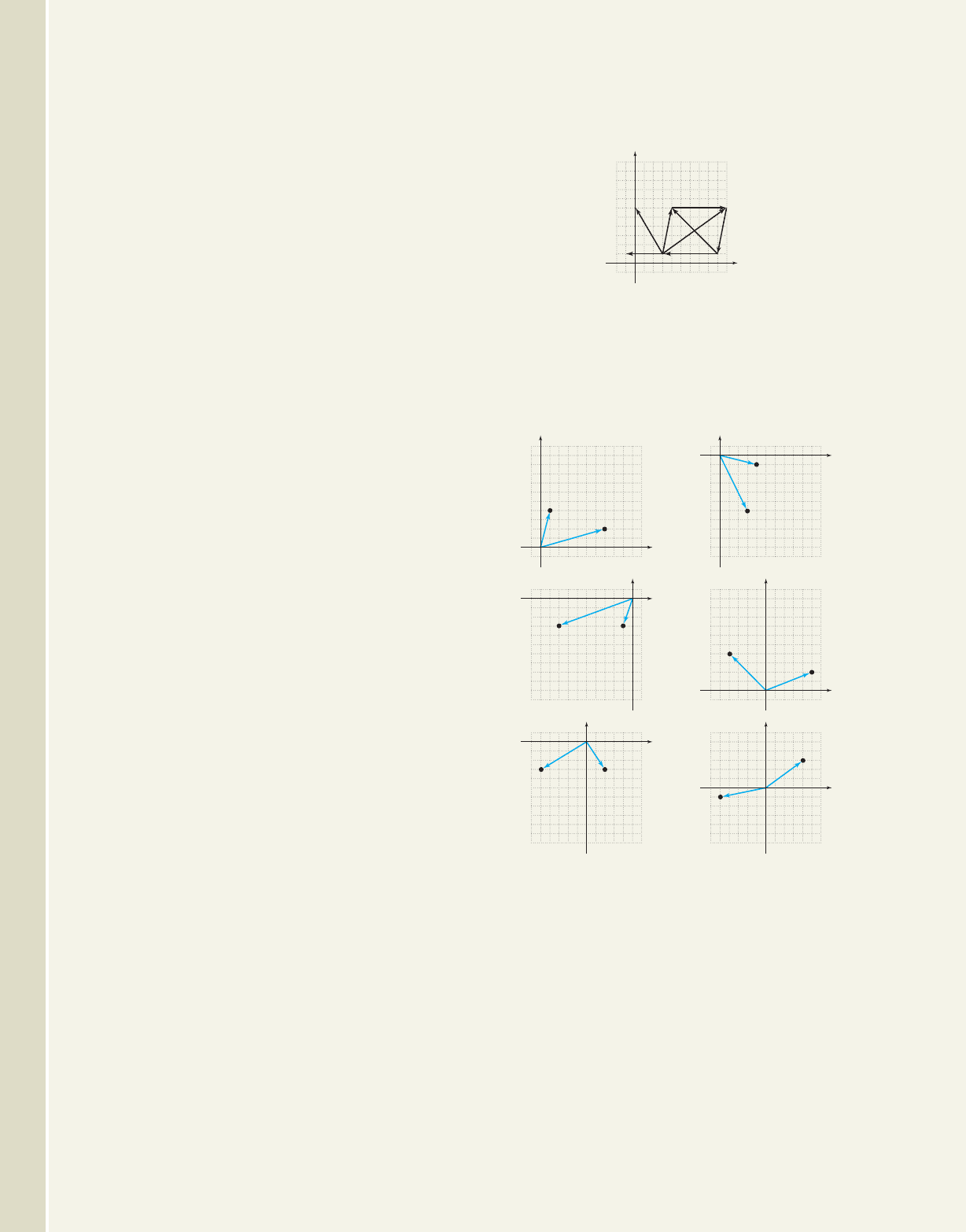
748 CHAPTER 7 Applications of Trigonometry 7-38
Draw the vector v indicated, then graph the equivalent
position vector.
13. initial point terminal point (4, 5)
14. initial point terminal point (2, 3)
15. initial point terminal point
16. initial point (1, 4); terminal point
For each vector and initial point (x, y) given, find
the coordinates of the terminal point and the magnitude
of the vector.
17. initial point
18. initial point
19. initial point (2, 6)
20. initial point
For each position vector given, (a) graph the vector
and name the quadrant, (b) compute its magnitude, and
(c) find the acute angle formed by the vector and the
nearest x-axis.
21. 22.
23. 24.
For Exercises 25 through 30, the magnitude of a vector
is given, along with the quadrant of the terminal point
and the angle it makes with the nearest x-axis. Find the
horizontal and vertical components of each vector and
write the result in component form.
25. QII
26. QIII
27. QIV
28. QI
29. QIII
30. QII
For each pair of vectors u and v given, compute (a) through
(d) and illustrate the indicated operations graphically.
a. b.
c. d.
31.
32.
33.
34.
35.
36. u H7, 3I; v H7, 3I
u H4, 2I; v H1, 4I
u H5, 3I; v H6, 4I
u H7, 2I; v H1, 6I
u H3, 4I; v H0, 5I
u H2, 3I; v H3, 6I
u 2v2u 1.5v
u vu v
r
4.75; 62°;
q
10; 15°;
p
15; 65°;
w
140.5; 41°;
u
25; 32°;
v
12; 25°;
H8, 6IH2, 5I
H7, 6IH8, 3I
13, 52v H8, 2I;
v H3, 5I;
15, 22v H6, 1I;
12, 32v H7, 2I;
v
v Ha, bI
12, 22
11, 2215, 32;
14, 42;
13, 22;
Use the graphs of vectors a, b, c, d, e, f, g, and h given to
determine if the following statements are true or false.
37. 38.
39. 40.
41. 42.
For the vectors u and v shown, compute and
and represent each result graphically.
43. 44.
45. 46.
47. 48.
Graph each vector and write it as a linear combination of i
and j. Then compute its magnitude.
49. 50.
51. 52.
For each vector here, represents the acute angle formed
by the vector and the x-axis. (a) Graph each vector, (b) find
the horizontal and vertical components and write the vector
in component form, and (c) write the vector in i, j form.
Round to the nearest tenth.
53. v in QIII,
54. u in QII,
55. w in QI,
56. v in QIV,
v
20,
r
32.6°
w
9.5,
r
74.5°
u
10.5,
r
25°
v
12,
r
16°
r
q H7.5, 3.4Ip H3.2, 5.7I
v H5, 12Iu H8, 15I
x
y
u
v
H5, 1I
H4
, 3I
x
y
u
v
H5, 3I
H2
, 3I
x
y
u
v
H4, 4I
H5
, 2I
x
y
u
v
H8, 3I
H1, 3I
x
y
u
v
H4, 1I
H3, 6I
x
y
u
v
H1, 4I
H7, 2I
u vu v
d f 0d e h
b h cc f h
f e ga c b
x
y
g
b
h
e
c
f
d
a
College Algebra & Trignometry—
cob19529_ch07_736-752.qxd 11/19/08 2:27 AM Page 748 epg HD 049:Desktop Folder:Satya 18/11/08:
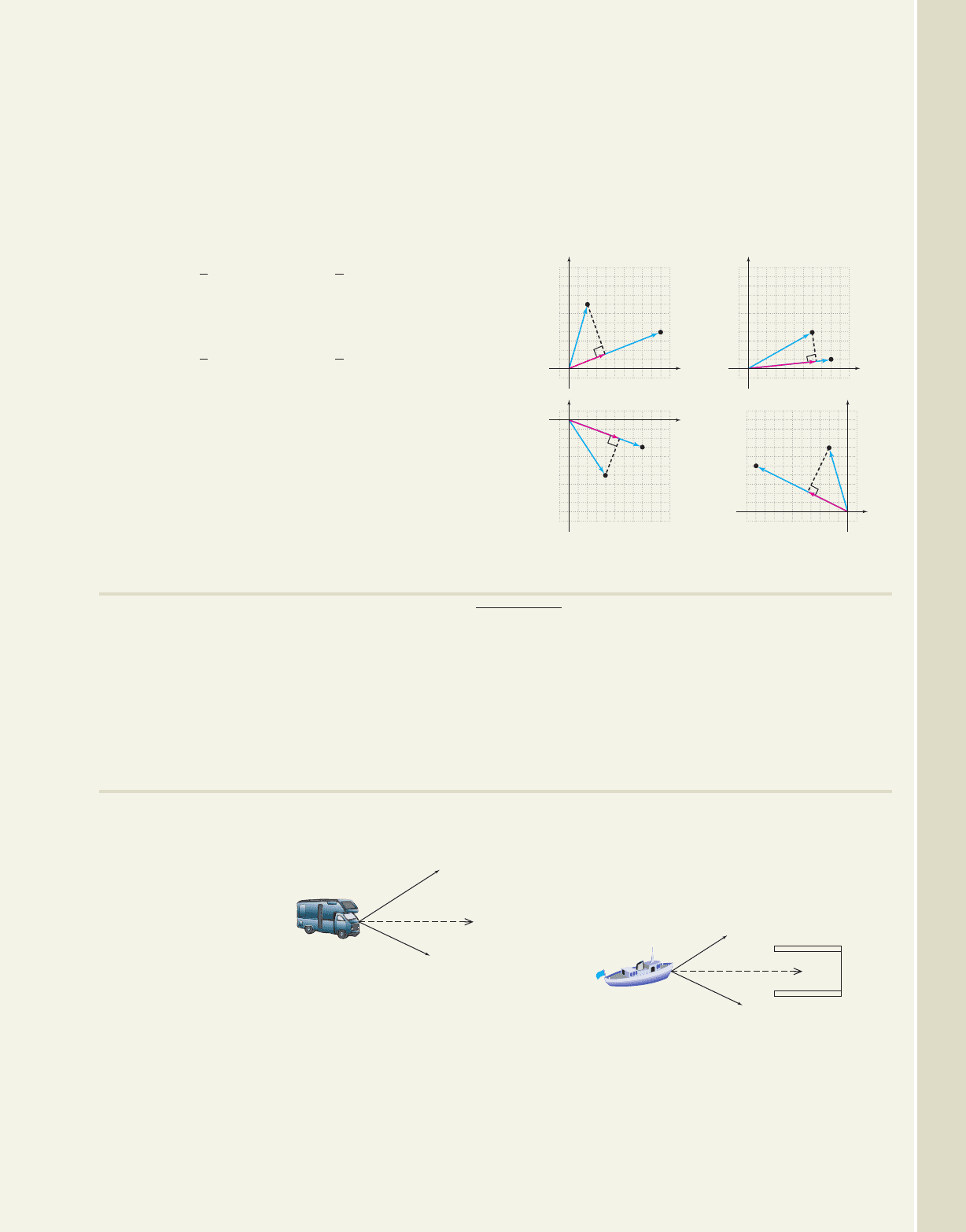
69. 70.
71. 72.
73. 74.
Vectors p and q form the angle indicated in each diagram.
Find the vector r that points in the same direction as q and
forms the base of the right triangle shown.
75. 76.
77. 78.
x
y
p
q
r
48
H2
, 7I
H10
, 5I
x
y
p
q
r
36
H8
, 3I
H4
, 6I
x
y
p
q
r
H9, 1I
23
H7
, 4I
x
y
p
q
r
H10, 4I
52
H2
, 7I
2.5i 7.2j6i 11j
v
2
H4, 7Iv
1
H13, 3I
9.6i 18j3.5i 12j
For vectors v
1
and v
2
given, compute the vector sums
(a) through (d) and find the magnitude and direction of each
resultant.
a. b.
c. d.
57.
58.
59.
60.
61.
62.
Find a unit vector pointing in the same direction as the
vector given. Verify that a unit vector was found.
63. 64.
65. 66.
67. 68. 4i 7.5j20i 21j
q H12, 35Ip H20, 21I
v H15, 36Iu H7, 24I
v
1
213i 6j; v
2
413i 2j
v
1
12i 4j; v
2
4i
v
1
6.8i 9j; v
2
4i 9j
v
1
512i 7j; v
2
312i 5j
v
1
7.8i 4.2j; v
2
5j
v
1
2i 3j; v
2
4i 5j
v
1
2v
2
s2v
1
1.5v
2
r
v
1
v
2
qv
1
v
2
p
7-39 Section 7.3 Vectors and Vector Diagrams 749
WORKING WITH FORMULAS
The magnitude of a vector in three dimensions:
v
2a
2
b
2
c
2
80. Find a cardboard box of any size and carefully
measure its length, width, and height. Then use the
given formula to find the magnitude of the box’s
diagonal. Verify your calculation by direct
measurement.
APPLICATIONS
81. Tow forces:A large van has careened off of the road
into a ditch, and two tow trucks are attempting to
winch it out. The cable
from the first winch
exerts a force of
900 lb, while the cable
from the second exerts
a force of 700 lb.
Determine the angle
for the first tow truck that will bring the van
directly out of the ditch and along the line
indicated.
W
1
W
2
32
82. Tow forces: Two tugboats are pulling a large ship
into dry dock. The first is pulling with a force of
1250 N and the second with a force of 1750 N.
Determine the angle for the second tugboat that
will keep the ship moving straight forward and into
the dock.
T
1
T
2
40
College Algebra & Trignometry—
79. The magnitude of a vector in three dimensional
space is given by the formula shown, where the
components of the position vector v are
Find the magnitude of v if v H5, 9, 10I.
Ha, b, cI.
83. Projectile components: An arrow is shot into the
air at an angle of with an initial velocity of
100 ft/sec. Compute the horizontal and vertical
components of the representative vector.
37°
84. Projectile components: A football is punted
(kicked) into the air at an angle of with an
initial velocity of 20 m/sec. Compute the
horizontal and vertical components of the
representative vector.
42°
cob19529_ch07_736-752.qxd 11/19/08 2:27 AM Page 749 epg HD 049:Desktop Folder:Satya 18/11/08:
